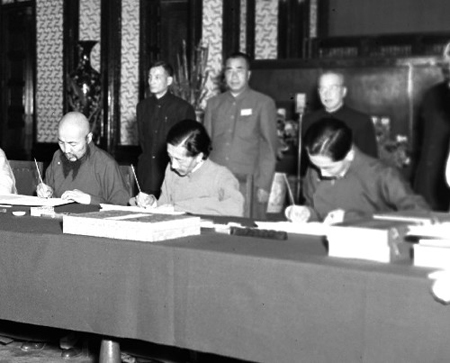Peaceful liberation of Tibet
 |
|
Delegates from Tibetan local government signed on the agreement, May 23, 1951. [File photo] |
At the end of 1949, the Chinese People's Liberation Army (PLA) prepared to enter Tibet after liberating major parts of south and southwest China.
Considering the specific situation in Tibet, the then central government of China noticed the local authorities of Tibet to send representatives to Beijing to hold negotiations on the peaceful liberation of Tibet.
However, the negotiations failed due to the obstruction by Tibetan upper-level reactionaries and imperialist forces.
On October 19, 1950, the PLA took over Qamdo -- the gateway to Tibet, and the Tibet authorities had to accept the arrangement proposed by the central government concerning Tibet's peaceful liberation.
In April 1951, the local authorities of Tibet sent a five-member delegation to Beijing including Ngapoi Nagwang Jigme to hold negotiations with Li Weihan and Zhang Jingwu, representatives of the Central Government. After several rounds of consultations, the two sides signed an agreement on May 23, declaring the peaceful liberation of Tibet.
According to the agreement, Tibet is a part of China; the local armed forces of Tibet became incorporated into the PLA; and the freedom of religious belief in Tibet is guaranteed.
In October 1951, the PLA came to Lhasa, the capital city of Tibet.
The peaceful liberation of Tibet was an important event in the modern history of China, as well as an epoch-making milestone in Tibetan history.
The peaceful liberation of Tibet proved that the policies of the Communist Party of China on ethnic minorities were correct and reflected the common aspiration and fundamental interests of the whole Chinese people including Tibetan people.
The peaceful liberation of Tibet laid a solid foundation for the unity and prosperity of the Newly founded People's Republic of China.
(Courtesy of Xinhua News Agency and Tibet -- Its Ownership And Human Rights Situation published by the Information Office of the State Council of The People's Republic of China)







